Anji Bridge: Unveiling the Secrets of China’s Ancient Engineering

An Essential Guide to Visiting Anji Bridge
In This Guide
- An Essential Guide to Visiting Anji Bridge
- The Rich History and Legends of Anji Bridge
- Main Highlights: What You Absolutely Can’t Miss
- Planning Your Visit: A Practical Guide
- Tickets: Prices, Booking, and Tips
- How to Get There: A Complete Transportation Guide
- Local Cuisine and Accommodation Nearby
- Frequently Asked Questions
- Final Thoughts on Your Trip
Nestled in the picturesque landscape of Zhao County, Hebei Province, Anji Bridge, also known as Zhaozhou Bridge, stands as a testament to ancient engineering and artistry. Dating back over 1,400 years to the Sui Dynasty, this magnificent structure is not only the oldest surviving open-spandrel stone arch bridge in the world but also a symbol of resilience, having withstood the ravages of time, including floods, wars, and earthquakes. Constructed under the skilled guidance of the renowned builder Li Chun, Anji Bridge exemplifies the ingenuity of ancient Chinese architecture.
As you approach the bridge, you will be greeted by the lush surroundings of Zhaozhou Bridge Park, where elegant pavilions and towering pines frame the scene, creating a serene atmosphere that invites exploration and reflection. The bridge itself, with its remarkable span of 37 meters and intricate design featuring 28 arches, serves as both a functional pathway and an artistic masterpiece. Its innovative structure has inspired countless engineers and architects, earning it recognition as a milestone in civil engineering and a cherished cultural relic.
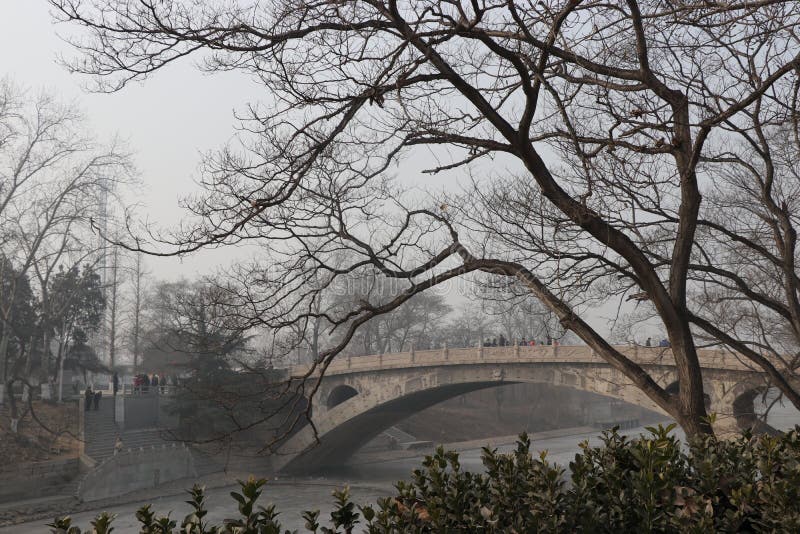
Anji Bridge.
Visiting Anji Bridge offers you an opportunity to step back in time and immerse yourself in the rich tapestry of Chinese history. The surrounding park not only enhances your experience with exhibitions showcasing the bridge’s construction and restoration but also provides a tranquil spot to enjoy a leisurely boat ride or savor local delicacies. Whether you are a history enthusiast, a photography lover, or simply seeking a peaceful retreat, Anji Bridge promises a unique journey through time, inviting you to discover the stories and legends woven into its ancient stones.
Key Highlights:
- Historical Significance: Discover the stories of resilience and innovation behind the bridge’s construction and its role in connecting northern and southern China.
- Architectural Marvel: Marvel at the intricate carvings and the elegant design that has withstood the test of time.
- Cultural Experience: Engage with local culture through exhibitions, traditional crafts, and regional cuisine available within the park.

Anji Bridge.
Prepare to be captivated by the blend of history and beauty that is Anji Bridge — a true gem of Chinese heritage waiting to be explored.
The Rich History and Legends of Anji Bridge
Nestled gracefully over the Xiaohe River in Zhao County, Anji Bridge, also known as Zhaozhou Bridge, stands as a testament to ancient Chinese engineering and artistry. Its history, spanning over 1,400 years, is rich with tales of innovation, resilience, and cultural significance that continue to captivate both historians and travelers alike.
A Marvel of Engineering
Constructed during the Daye period (605-618 A.D.) of the Sui Dynasty, Anji Bridge was designed by the eminent engineer Li Chun. Recognized as the earliest and best-preserved open-spandrel stone arch bridge in existence, it showcases an architectural innovation that was ahead of its time. The bridge spans 64 meters (211 feet) and features a main arch with a clear span of 37 meters (121 feet), supported by a sophisticated arrangement of 28 smaller arches. This unique design not only reduces the amount of stone required but also enhances stability and facilitates the flow of floodwaters—a crucial feature given the region’s history of natural disasters.
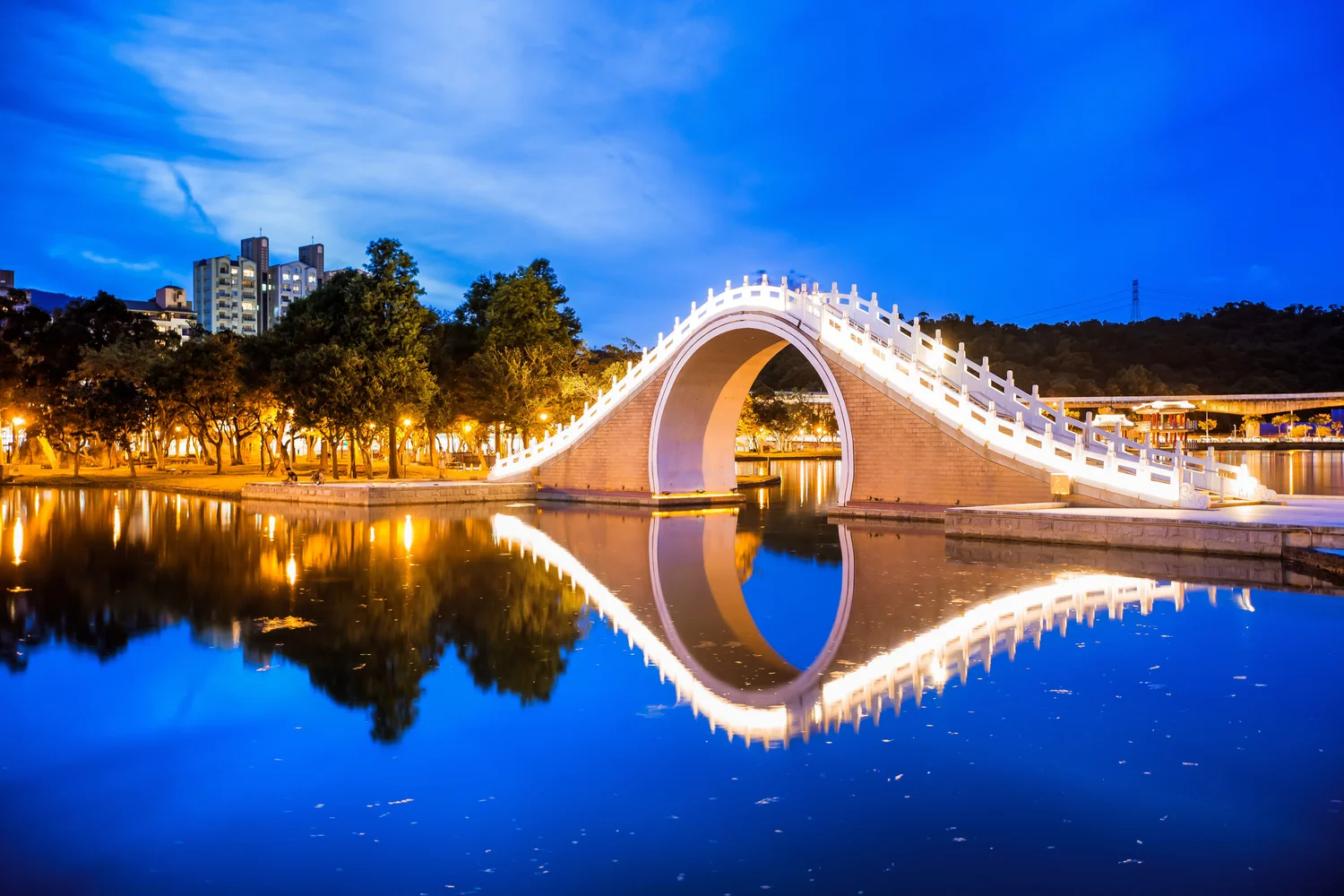
Anji Bridge.
The bridge’s durability is legendary. It has withstood at least ten significant floods, eight wars, and numerous earthquakes, including a powerful 7.6 magnitude quake in 1996, located only 40 kilometers away. Its resilience has earned it the nickname “Indestructible for a Thousand Years,” a title that reflects both its structural integrity and its enduring place in Chinese culture.
Tales of the Past
Anji Bridge is not just a functional structure; it is steeped in folklore and historical anecdotes. One popular legend tells of its construction being guided by celestial beings, imbued with the wisdom of the ancients. It is said that Li Chun, inspired by a dream of a dragon, incorporated dragon motifs and other intricate carvings into the bridge’s design, symbolizing strength and protection. These carvings, featuring dragons, flowers, and mythical figures, embody the essence of Sui-era artistry, making the bridge not only a functional pathway but also a canvas of cultural expression.

Anji Bridge.
Emperor Zhezong of the Song Dynasty, impressed by its beauty and significance, named it “Anji,” which translates to “Ensuring Safe Lives and Aiding People.” This imperial recognition further solidified the bridge’s status as a cultural icon, representing the unity and connectivity of the Chinese people during its time.
Architectural Significance
The architectural advancements seen in Anji Bridge have influenced bridge construction worldwide. As the world’s oldest and most scientifically sophisticated open-spandrel stone arch bridge, it is often compared to monumental structures like the Eiffel Tower and the Panama Canal. In 1961, it was designated a national cultural relic by China’s State Council, and in 1991, it was honored as the twelfth “milestone of international civil engineering” by the American Society of Civil Engineers.
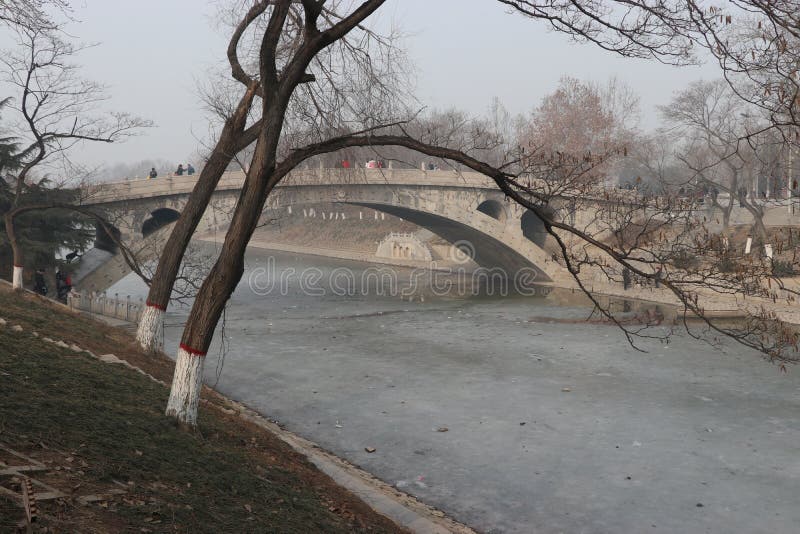
Anji Bridge.
The bridge’s design principles, particularly its open-spandrel arches that allow for efficient water drainage, have inspired countless engineers and architects throughout history. It serves as both a practical crossing and an enduring symbol of ingenuity.
Cultural Legacy
Today, Anji Bridge is not merely a historical site; it is a cultural hub that draws visitors from around the globe. The surrounding Zhaozhou Bridge Park features exhibitions showcasing the bridge’s construction and restoration history, alongside opportunities to engage with local art forms such as stone carving and paper cutting. Visitors can immerse themselves in the legends of the bridge while enjoying the serene landscape, making it a perfect spot for reflection and appreciation of the artistry behind one of China’s most cherished monuments.
Conclusion
Anji Bridge stands as a remarkable fusion of functionality and artistry, embodying the spirit of resilience and innovation that defines Chinese culture. Its legends and historical significance continue to resonate, making it a must-visit destination for anyone interested in the rich tapestry of China’s architectural heritage. Whether you are walking across its ancient stones or simply admiring its majestic beauty from the banks of the Xiaohe River, Anji Bridge offers a unique glimpse into the past that shapes the present.

Anji Bridge.
Main Highlights: What You Absolutely Can’t Miss
Discovering the Timeless Beauty of Anji Bridge (Zhaozhou Bridge)
Anji Bridge, also known as Zhaozhou Bridge, is not just a marvel of ancient engineering; it is a testament to the ingenuity of Chinese craftsmanship that has withstood the test of time. Spanning over 1,400 years of history, this iconic bridge is a must-visit for anyone interested in Chinese culture and architecture. Here are the main highlights that you absolutely can’t miss during your visit.
1. Architectural Marvel
- Historical Significance: Built during the Sui Dynasty (605-618 A.D.) by the esteemed craftsman Li Chun, Anji Bridge is the oldest and best-preserved open-spandrel stone arch bridge in the world. Its unique design allows for the passage of floodwaters, which has contributed to its remarkable durability.
- Design Features: The bridge stretches 64 meters (211 feet) in length, with a main span of 37 meters (121 feet). Its construction comprises 28 smaller arches that form a visually striking single arch, showcasing the sophistication of ancient engineering.

Anji Bridge.
2. Cultural Richness
- Sculptural Artistry: As you stroll across the bridge, take a moment to admire the intricate carvings that adorn its balusters. Each of the 44 balusters features unique designs, including dragons, flowers, and mythical creatures, reflecting the artistic style of the Sui period.
- Bridge Museum: Don’t miss the opportunity to visit the Bridge Museum within the scenic area. Here, you can explore ancient bridge-building tools and models, diving deeper into the rich history and significance of this architectural wonder.
3. Breathtaking Scenic Views
- Park Setting: Located in Zhaozhou Bridge Park, the bridge offers a picturesque setting surrounded by lush greenery, serene water, and traditional pavilions. The contrast of the ancient bridge against the natural landscape makes for stunning photo opportunities.
- Leisure Activities: Engage in leisurely pursuits such as boating on the crystal-clear waters or relaxing in the shaded pavilions. The tranquil environment invites visitors to unwind and soak in the beauty of the surroundings.
4. Interactive Experiences
- Cultural Performances: Be on the lookout for local cultural performances that showcase traditional crafts such as stone carving and paper cutting. These performances offer an immersive glimpse into the intangible cultural heritage of the region.
- Local Cuisine: After exploring, treat yourself to local delicacies at nearby food stalls. Don’t miss the famed Zhaoxian donkey meat and crispy sesame flatbreads, which are not only delicious but also a part of the local culinary tradition.
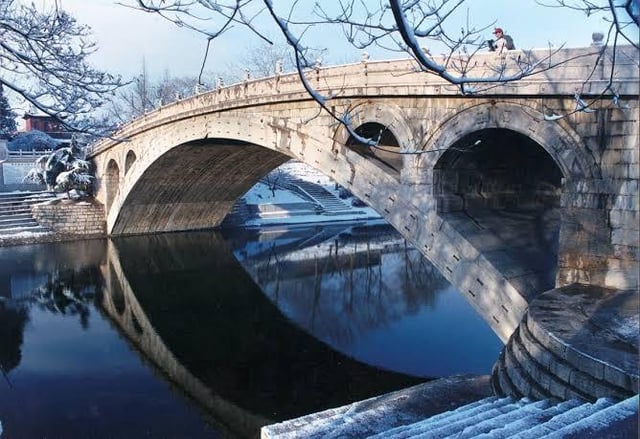
Anji Bridge.
5. Convenient Access
- Getting There: Anji Bridge is easily accessible from Shijiazhuang. You can take a bus from Shijiazhuang Nanjiao Bus Station to Zhao County, followed by a short taxi ride to the park. Alternatively, consider driving for a more personal experience.
- Entry Fee: The entrance fee to Zhaozhou Bridge Park is CNY 40, with free admission for children under 1.2 meters. The park is open from 9:00 AM to 5:00 PM, allowing ample time to explore.
Conclusion
Visiting Anji Bridge is more than just an exploration of an architectural masterpiece; it’s a journey through time that connects you with China’s historical and cultural narrative. Whether you are an architecture enthusiast, history buff, or simply looking for a beautiful place to relax, Anji Bridge offers a unique experience that you won’t soon forget. Make sure to carve out a few hours in your itinerary to fully appreciate this remarkable site and all it has to offer!

Anji Bridge.
Planning Your Visit: A Practical Guide
Getting Ready for Your Journey to Anji Bridge
When planning your visit to the remarkable Anji Bridge, also known as Zhaozhou Bridge, you’ll want to ensure a smooth experience as you delve into the rich history and stunning architecture of this ancient marvel. This guide will equip you with essential information to make the most of your trip.
Location and Access
Anji Bridge is located approximately 25 kilometers (about 15.5 miles) southeast of Shijiazhuang City, in Zhao County. The bridge stands majestically over the Xiaohe River and is nestled within the serene Zhaozhou Bridge Park, making it an ideal spot for both history enthusiasts and nature lovers.
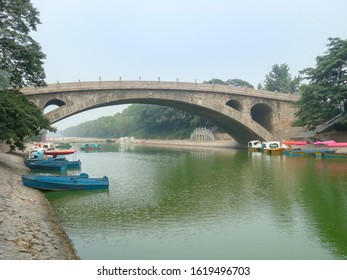
Anji Bridge.
How to Get There
- Public Transport:
- Bus: From Shijiazhuang Nanjiao Bus Station, take a bus to Zhao County. The journey takes about 1 hour. Once you arrive, you can catch a taxi or board Zhao County Bus 2 to reach Zhaozhou Bridge Park.
-
High-speed Rail: For those coming from farther away, the high-speed rail from Shijiazhuang Station to Zhaozhou Bridge Station is a great option. A quick taxi ride (about 10 minutes) will take you to the scenic area.
-
Self-Driving: If you prefer the convenience of a personal vehicle, the drive from Shijiazhuang city center takes about 1 hour via the Jinggang’ao Expressway, with ample parking available at the scenic area (approximately 10 RMB/day).
Park Hours and Admission
- Opening Hours: The park is open daily from 9:00 AM to 5:00 PM.
- Admission Fee: Entry to the park is CNY 40. Children under 1.2 meters (3.9 feet) tall may enter for free.

Anji Bridge.
What to Expect
Architectural Marvel
Anji Bridge is celebrated for being the oldest and best-preserved open-spandrel stone arch bridge in the world, with a history spanning over 1,400 years. Designed by the renowned craftsman Li Chun during the Sui Dynasty, its elegant structure boasts a main arch of 37 meters (121 feet) and a total length of 64 meters (211 feet). The bridge’s innovative design not only facilitates water flow but also minimizes the use of materials, showcasing ancient engineering ingenuity.
Cultural Immersion
As you explore the park, you’ll discover:
– Sculptures and Carvings: Admire the intricate baluster carvings, each depicting unique patterns, including dragons and floral motifs—a testament to the artistry of Sui sculpture.
– Bridge Museum: Located within the park, this museum offers insightful exhibits on ancient bridge construction techniques and the history of Anji Bridge. It’s a must-visit for families and those interested in engineering.
– Leisure Activities: You can row a boat on the tranquil waters, relax under the pavilions, or enjoy a cup of tea while absorbing the stories and legends surrounding this historical site.
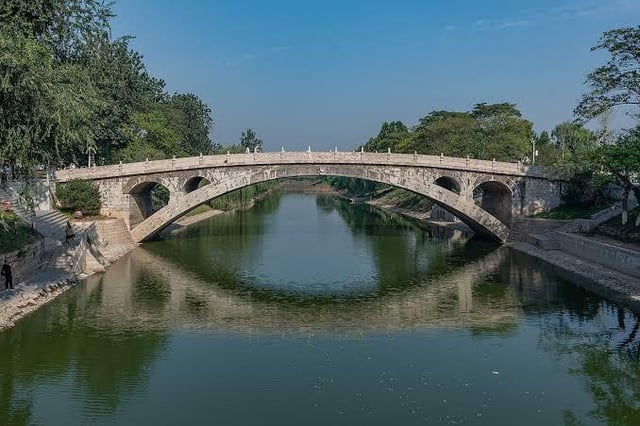
Anji Bridge.
Suggested Itinerary
For a fulfilling visit, consider the following schedule:
– 9:00 AM: Arrive at Zhaozhou Bridge Park. Start with a photo at the entrance.
– 9:30 AM: Walk along the bridge, marveling at its architecture and detailing.
– 11:00 AM: Visit the Bridge Museum to learn about its historical significance.
– 12:00 PM: Enjoy lunch at one of the local eateries within the park.
Local Delicacies to Try
While you’re in the area, indulge in these local specialties:
– Zhaoxian Donkey Meat: Tender and flavorful, served with freshly baked flatbread.
– Xuejia Shaobing (Sesame Flatbread): Crispy and delicious, available in both savory and sweet options.
– Ganglu Shaobing with Meat: A local favorite, this flaky pastry filled with braised pork is a must-try.
Where to Stay
If you’re planning to stay overnight, here are some accommodation options:
– Yijia 365 (Zhaozhou Bridge Branch): Budget-friendly and just a short walk from the park.
– Shangkeyou Express Hotel: Mid-range comfort with easy access to dining options.
– Zhaozhou Hotel: A unique experience in a beautiful garden-style hotel, offering authentic local cuisine.
Final Thoughts
A visit to Anji Bridge promises a deep dive into China’s architectural heritage and a chance to witness the blend of history, culture, and natural beauty. Whether you’re a history buff, an architecture aficionado, or simply a curious traveler, this remarkable site is sure to leave you with lasting memories. Make sure to bring your camera, as every angle offers a glimpse into the past that is simply breathtaking!
Tickets: Prices, Booking, and Tips
Discovering Anji Bridge: Ticketing and Tips for Your Visit
Anji Bridge, also known as Zhaozhou Bridge, is a remarkable piece of history that beckons travelers with its architectural beauty and cultural significance. As you plan your visit, here’s what you need to know about tickets, pricing, and some handy tips to enhance your experience.
Ticket Information
- Entry Fee:
- The cost to visit Anji Bridge is CNY 40 (approximately USD 6).
-
Free Admission: Children under 1.2 meters (3.9 feet) in height can enter without charge.
-
Opening Hours:
- The scenic area is open daily from 9:00 AM to 5:00 PM. Ensure you arrive with enough time to explore before closing.
Booking Options
-
On-Site Purchase: Tickets can be purchased directly at the entrance of the Zhaozhou Bridge Park. It is advisable to arrive early, especially during peak seasons, to avoid long queues.
-
Online Booking: Depending on the season and special events, some platforms may offer the option to book tickets online. Check local travel websites or apps for any available deals or features.
Getting There
- From Shijiazhuang: The bridge is located approximately 25 kilometers (about 15.5 miles) southeast of Shijiazhuang City. Here are three convenient ways to reach the site:
- Public Bus: Take a bus from Shijiazhuang Nanjiao Bus Station to Zhao County, which takes about 1 hour. From there, catch a taxi or take Zhao County Bus 2 to the scenic area.
- Self-Drive: If you prefer driving, the journey from Shijiazhuang city center takes around 1 hour via the Jinggang’ao Expressway. Ample parking is available at the scenic area for a fee of CNY 10 per day.
- High-Speed Rail: Take the high-speed train from Shijiazhuang Station to Zhaozhou Bridge Station. A taxi ride from the station to the scenic area takes about 10 minutes. High-speed rail tickets are reasonably priced at around CNY 18.
Tips for Your Visit
-
Plan Ahead: Allocate 2 to 4 hours for a thorough exploration of the bridge and its surroundings. This will give you ample time to appreciate the intricate carvings and the historical significance of the structure.
-
Photography: Don’t miss the chance to capture stunning photographs! The best views of the bridge can be taken from various angles, especially at dawn or dusk when the lighting is magical.
-
Local Cuisine: While visiting, indulge in local delicacies such as Zhaoxian Donkey Meat and Xuejia Shaobing. Snack streets near the scenic area offer a variety of tasty treats that are perfect for a quick bite.
-
Cultural Experiences: Explore the Bridge Museum located within the park, where you can learn about ancient bridge-making techniques and see traditional craftsmanship.
-
Relaxation Spots: Take breaks in the riverside pavilions, where you can enjoy the serene atmosphere, sip tea, and read about the legends associated with the bridge.
Visiting Anji Bridge is not just about crossing a historic structure; it’s an opportunity to immerse yourself in China’s rich architectural heritage. With this guide, you’re well-equipped to enjoy a memorable trip to one of China’s oldest and most celebrated bridges.
How to Get There: A Complete Transportation Guide
Navigating Your Way to Anji Bridge
Visiting the Anji Bridge, also known as Zhaozhou Bridge, promises to be a journey through time, showcasing an architectural marvel that has stood since the Sui Dynasty. With its rich history and stunning design, getting there is an adventure in itself. Here’s a comprehensive guide to help you reach this historic site seamlessly.
From Shijiazhuang to Anji Bridge
Anji Bridge is located approximately 25 kilometers (15.5 miles) southeast of Shijiazhuang, the capital of Hebei Province. Here are the most convenient transportation options:
1. By Public Bus
- Departure Point: Shijiazhuang Nanjiao Bus Station
- Bus Route: Take a bus directly to Zhao County.
- Duration: Approximately 1 hour.
- Cost: Around CNY 20 (less than $3).
- Upon Arrival: After arriving at Zhao County, you can either take a taxi or catch Bus 2 to reach Zhaozhouqiao Jingqu (Zhaozhou Bridge Park).
2. By High-Speed Rail
- Departure Station: Shijiazhuang Railway Station
- Train Route: Board a high-speed train to Zhaozhou Bridge Station.
- Duration: The train ride takes about 30 minutes.
- Cost: Tickets are priced at CNY 18 (approximately $2.50).
- Final Leg: From Zhaozhou Bridge Station, you can take a taxi for a quick 10-minute ride to the scenic area.
3. Self-Driving
- Route: If you prefer to drive, take the Jinggang’ao Expressway, then transfer to the Qingyin Expressway.
- Duration: The drive is roughly 1 hour under normal traffic conditions.
- Parking: Ample parking is available at the scenic area for a fee of CNY 10/day (about $1.50).
Exploring the Scenic Area
Once you arrive at Zhaozhouqiao Park, prepare to be captivated by the beauty of Anji Bridge and its surroundings. The entrance fee to the park is CNY 40, with free entry for children under 1.2 meters (3.9 feet) tall. The park is open from 9:00 AM to 5:00 PM, allowing you plenty of time to explore its many attractions.
Tips for Your Visit
- Best Time to Visit: Early mornings are ideal for photography, as the light is soft and the park is less crowded.
- Local Delicacies: Don’t miss out on trying local specialties such as Zhaoxian Donkey Meat and Xuejia Shaobing, available at food stalls within the scenic area.
- Cultural Engagement: Take the time to visit the Bridge Museum located nearby, where you can learn about the ancient techniques used in bridge construction.
Conclusion
Whether you opt for public transport, a speedy train ride, or a leisurely drive, reaching Anji Bridge is straightforward and enjoyable. This remarkable structure isn’t just a bridge; it’s a testament to China’s rich history and architectural ingenuity, waiting for you to discover its stories. Happy travels!
Local Cuisine and Accommodation Nearby
When visiting the magnificent Anji Bridge, also known as Zhaozhou Bridge, immerse yourself not only in its architectural splendor but also in the rich flavors of local cuisine and comfortable accommodations nearby. This region of Hebei is a treasure trove of culinary delights and hospitable lodgings that will enhance your experience of this historic site.
Culinary Delights
1. Zhaoxian Donkey Meat
– Description: A local specialty renowned for its tenderness, Zhaoxian donkey meat is often served with freshly baked flatbread. Its rich flavor is a must-try, and many visitors swear by its melt-in-your-mouth texture.
– Where to Try: Check out the “Time-honored Donkey Meat Restaurant” located at the entrance of the scenic area.
2. Xuejia Shaobing (Sesame Flatbread)
– Description: These crispy, golden flatbreads come in both savory and sweet varieties and are best enjoyed fresh off the grill. A perfect snack or souvenir, they are priced at just around 1 RMB each.
– Tip: Don’t miss the chance to savor them while they’re still warm!
3. Ganglu Shaobing with Meat
– Description: A delightful local treat, this crispy shaobing is filled with savory braised pork, delivering a satisfying crunch with every bite.
– Recommendation: Ideal for those looking to indulge in hearty comfort food.
Accommodation Options
Best Value
– Yijia 365 (Zhaozhou Bridge Branch)
– Distance: About a 10-minute walk from the scenic area.
– Features: Clean rooms, breakfast included, and friendly service.
– Price: Approximately 150 RMB per night per person.
Mid-Range Comfort
– Shangkeyou Express Hotel (Zhaoxian Shiqiao Street Branch)
– Distance: Conveniently located near the food street, perfect for evening strolls and dining.
– Features: Comfortable bedding, free parking, and easy access to local attractions.
– Price: Around 220 RMB per night per person.
Unique Experience
– Zhaozhou Hotel
– Distance: Situated about 1.5 km from the scenic area.
– Features: A star-rated hotel boasting a traditional Chinese garden style, complete with its own restaurant serving authentic Zhaozhou dishes.
– Price: Approximately 400 RMB per night per person.
Final Thoughts
As you explore the Anji Bridge and its surrounding beauty, treat yourself to the delightful local delicacies and choose from a range of accommodations that suit your style and budget. This blend of historic charm, culinary adventure, and comfortable lodgings will undoubtedly make your visit to Zhaozhou Bridge a memorable experience.
Frequently Asked Questions
Frequently Asked Questions
1. What is Anji Bridge (Zhaozhou Bridge)?
Anji Bridge, also known as Zhaozhou Bridge, is a historic stone arch bridge located in Zhao County, Hebei Province, China. It was built during the Sui Dynasty (605-618 A.D.) and is recognized as the world’s oldest existing open-spandrel stone arch bridge.
2. How do I get to Anji Bridge from Shijiazhuang?
To reach Anji Bridge from Shijiazhuang, you can take a bus from the Shijiazhuang Nanjiao Bus Station to Zhao County, which takes about one hour. From Zhao County, you can either take a taxi or catch Bus 2 to Zhaozhou Bridge Park.
3. What are the entrance fees and opening hours?
The entrance fee to Anji Bridge is CNY 40, and it is free for children under 1.2 meters (3.9 feet). The bridge is open to visitors daily from 9:00 AM to 5:00 PM.
4. What are the main features of Anji Bridge?
Anji Bridge spans 64 meters (211 feet) in total length, with a main arch span of 37 meters (121 feet). It features a sophisticated design with 28 arches, which enhances its stability and aesthetic appeal. The bridge is adorned with intricate sculptures, including dragons and flowers, showcasing the artistic style of the Sui Dynasty.
5. Is there anything to do near Anji Bridge?
Yes! The surrounding area includes Zhaozhou Bridge Park, where visitors can enjoy scenic views, visit a bridge museum, and experience cultural performances. You can also explore ancient streets, ride boats on the river, and sample local delicacies at nearby food stalls.
6. How can I maximize my visit to Anji Bridge?
For a fulfilling experience, plan to spend 2-4 hours at the site. Start with a photo at the entrance, explore the bridge, visit the museum, and enjoy local snacks. Consider visiting during weekdays or early mornings to avoid crowds.
7. Are there any accommodations nearby?
Yes, there are several accommodation options near Anji Bridge ranging from budget-friendly guesthouses to mid-range hotels. Some recommended options include Yijia 365 (Zhaozhou Bridge Branch) and Zhaozhou Hotel, which offer comfortable stays with easy access to the bridge.
8. What is the historical significance of Anji Bridge?
Anji Bridge holds immense historical significance as a masterpiece of ancient engineering. It has survived numerous floods, wars, and earthquakes over its 1,400-year history, symbolizing resilience and ingenuity. It is recognized as a national key cultural relic and has been honored internationally as a milestone in civil engineering.
Final Thoughts on Your Trip
As you conclude your journey to the magnificent Anji Bridge, also known as Zhaozhou Bridge, reflect on the rich tapestry of history and culture that envelops this architectural marvel. Spanning over 1,400 years, this ancient stone arch bridge not only stands as a testament to the ingenuity of its designer, Li Chun, but it also embodies the resilience and spirit of the Chinese people throughout the ages.
Key Takeaways from Your Visit
-
Historical Significance: You have walked across one of the oldest and most renowned open-spandrel stone arch bridges in the world, a symbol of engineering brilliance that has withstood floods, wars, and earthquakes.
-
Cultural Immersion: The surrounding Zhaozhou Bridge Park offers a serene environment enriched with sculptures, traditional performances, and insights into ancient bridge-building techniques, allowing you to connect with the local heritage in a meaningful way.
-
Natural Beauty: The picturesque setting of the bridge, framed by lush greenery and tranquil waters, invites you to pause and appreciate the beauty of nature that exists in harmony with human achievement.
-
Culinary Delights: Your trip would be incomplete without savoring local delicacies, from the flavorful Zhaoxian donkey meat to the crispy shaobing, each bite adding another layer to your experience of this vibrant region.
Final Reflections
Whether you choose to relax under a pavilion or take leisurely boat rides on the Xiaohe River, the memories you create here will linger long after your visit. Anji Bridge is not just a bridge; it is a gateway to understanding the profound connection between architecture, culture, and history in China. As you depart, carry with you the stories of the past and the inspiration of the present, and let them influence your own journey as a traveler in this ever-evolving world.
Your exploration of Anji Bridge is a chapter in a larger narrative—one that celebrates human creativity and the timeless quest for connection. Safe travels, and may your adventures continue to inspire you!